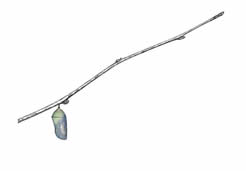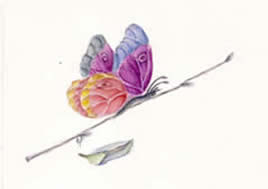
During the life of the caterpillar,
its brain continuously produces and releases a hormone
whose function is to keep the caterpillar in the caterpillar stage.
After it has gone through its final molting, the level of hormone drops.
The insect attaches to a surface such as the twig above,
and begins producing chemicals that accumulate on its body surface
and harden into a beautiful chrysalis.
Protected inside the chrysalis, the production of hormone ends,
and the caterpillar’s body almost completely dissolves into a liquidy mush.
Then, clumps of cells called imaginal discs become very active.
They contain the DNA-coded instructions
that build the butterfly from the liquidy mush.
The organs and structures of the butterfly begin to form.
When ready, a signal - environmental or genetic programming -
triggers a burst of another hormone inside the butterfly’s body.
It secretes a liquid that softens the walls of the chrysalis,
which become transparent, then cloudy
(in the chrysalis above, its wings are beginning to show).
With great effort, the butterfly pushes with its legs and head
to create an opening in the chrysalis
through which it can emerge.
It is the effort of escaping from the chrysalis
that strengthens it for its next phase of life.
If an outside force helps the butterfly by cutting open the chrysalis,
the butterfly does not live as long as it would if it had done the work itself.
The harder the butterfly has to struggle to emerge from the chrysalis,
the longer it lives.
It hangs upside down to rest
and to dry, stretch out, and pump fluid into its wings
to expand them into their final functional form.
And then
It is ready to fly

With thanks to Martha Beck and to The Lepidopterist Society for much of the above information,
and to Bonnie Fremgen for the beautiful watercolor painting of my butterfly logo.